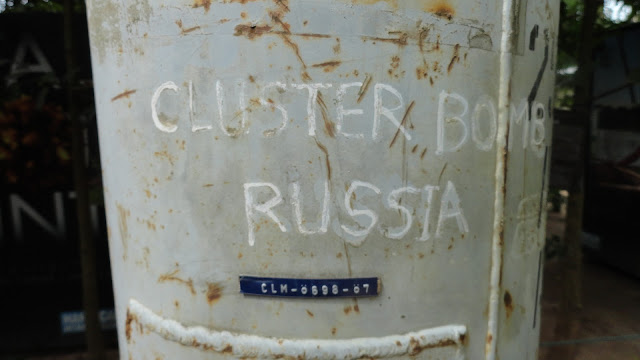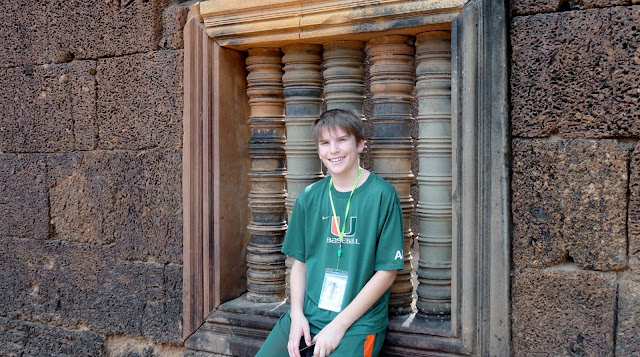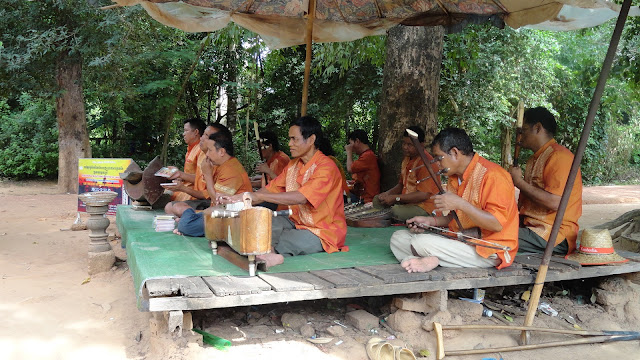Cambodia, especially in its rural areas, has a major problem with landmines placed during almost three decades of war. From the early 1970's through the late 1990's, landmines were placed throughout Cambodia by Khmer Rouge armies, Vietnamese forces and Cambodian factions that clashed during the Civil War. Although these conflicts ended almost 15 years ago, the landmines laid during them continue to pose a severe risk to the population of rural Cambodia. Although my guidebooks warned about the dangers of venturing off of marked paths and roads, I didn't realize the real and present danger of landmines and the extent of their impact on the Cambodian people.
.jpg)

Cambodia has one of the highest rates in the world of amputees resulting from landmine injuries (40,000 people) and one of the highest casualty rates from landmines in the world. Most of the victims of landmines in Cambodia are males of working age living in rural Cambodia at the poverty level and with extremely limited access to good health care. There are almost no government subsidies or other types of aid provided to those who are disabled or otherwise in need. When a family has a contributing member lose a limb (or his life) or become otherwise disabled from landmine explosion, it puts a heavy financial burden on that family and reduces its capacity to improve its socio-economic situation.
Even just the possibility that landmines might be present in the fields or in the forests prevents farmers from cultivating the land and expanding their capabilities to grow more crops or raise more animals. The threat of landmines renders perfectly good agricultural land useless and also restricts the population's access to water and other important natural resources, effectively limiting the population's ability to advance its socio-economic level.
Sopheap told us it is estimated that there are between 4 Million and 6 Million landmines that have yet to be found in Cambodia. Most of the remaining landmines are found in the Northwest part of Cambodia (along the border with Thailand), the last stronghold of the Khmer Rouge. Since no records or documentation were kept to track where the landmines were placed, locating them is a very difficult task and dependent on a lot of financial investment and skilled human resources. If the current level of funding ($30 Million per year) is maintained, it will take between 15-20 years for Cambodia to be cleared of landmines.
In addition to the dangers posed by landmines, Cambodians are mindful of the hundreds of un-exploded munitions that are scattered throughout the Cambodian countryside. Massive amounts of cluster bombs were used by the United States in the 1970's in Cambodia and Vietnam to attack columns of Vietnamese armored vehicles as they traveled along the Eastern border of Cambodia from Hanoi to Saigon. Although cluster bombs are intended to explode immediately upon impact, the detonation mechanisms often failed and many did not explode. These un-exploded cluster bombs pose the same danger as landmines to civilians as they can explode at the slightest touch from someone who may inadvertently come into contact with one during daily farming or land development activities.
"OUR MISSION
The Cambodian Landmine Museum Relief Facility (CLMMRF) is more than a museum. It is also a home that provides education and support for dozens of at-risk youth and landmine affected children rescued by the CLMMRF NGO. Many children who are part of this family suffered overwhelming hardships. The Cambodian Landmine Museum Relief Facility was created so that it might serve as a place of healing for bodies, hearts and minds. We believe that love, support and education will help secure a better opportunity for the children that live here.
WHO WE ARE
The Cambodia Landmine Museum is a Cambodian NGO, run by and for Cambodians.
It exists for three reasons:
* To tell the story of landmines in Cambodia, how they have impacted the country’s past, present and will continue to impact its future. The story is told through the story of Aki Ra, our founder, who was suppressed into the Khmer Rouge Army as a child soldier, and spent his youth fighting in the wars that ravaged his country for nearly 35 years.
* To show the world that, no matter who you are, whatever your background, your education, you can make a difference in this world.
* The Museum hosts a Relief Facility for at-risk village children. The money raised by the museum allows this facility to continue. At the present time (late 2012) the Museum supports a community of nearly 75 men, women, and children.
The Cambodian Landmine Museum and Relief Facility (Museum for short) was established in 1997 by ex-child soldier Aki Ra. After years of fighting he returned to the villages in which he planted thousands of mines and began removing them, by hand, and defusing them with homemade tools.
In 2008 he established a formal demining NGO, Cambodian Self Help Demining (CSHD) -www.cambodianselfhelpdemining.org. CSHD, a separate NGO from the Museum, which clears landmines in small villages throughout the country.
While working to make his country safe, Aki Ra saw many children wounded by landmines and living desperately poor lives. He brought them to his home, where he and his wife raised them as their own, alongside their own children. Originally all the children at the facility were landmine victims. Today the Facility cares for children who suffer from a variety of physical, emotional, and familial difficutlies.
The Relief Facility houses over 3 dozen children from small villages in Cambodia. All children are educated, and are provided with continuing education. The Facility has its own school to augment the children’s public education, a computer lab, a library, English language classes, a playground, and a staff of 14."
The following are a few photos that Christopher and I took while walking around the Museum.
The photo below shows some of the collection of landmines that Aki Ra has accumulated through his de-mining work.
The children in the school put together the exhibit in the photos below to show the different uniforms worn and the weapons used by the soldiers.
After we finished our tour of the museum, Sopheap drove us back to Siem Reap. Along the way, he stopped the car and picked something from a tree growing by the side of the road. This was one of those, "you learn something new every day" moments...
Guess what this is?
While we were all familiar with a cashew nut (the kids love PeePorn's Chicken with Cashew), we had no idea that an edible cashew apple grows attached to the cashew nut. The cashew nut is the "true" fruit of the tree and grows at the end of the cashew apple. The apple is called an accessory fruit and was very sweet and juicy. The texture and the juiciness reminded me of a tomato.
Back in Siem Reap, we toured the Artisans d'Angkor Chantiers-Ecoles. From their website,
"Artisans Angkor is a Cambodian company which was originally created to help young rural people find work near their home village. As the offshoot of an educational project called Chantiers-Ecoles de Formation Professionnelle, aiming at providing professional skills to communities with limited educational opportunities, Artisans Angkor has maintained its commitment to education by developing its own training program.
Since its creation at the end of 1990s, Artisans Angkor has strived to offer good working conditions and social advantages to its employees. It has now opened 42 workshops in Siem Reap province and it provides employment to over 1300 people, including more than 900 artisans.
Over the years, Artisans Angkor has become a real showcase of Khmer workmanship for its silk fabrics and garments, stone and wood carving, lacquer ware, polychrome products, silver plating and silk painting. Not only does the company revive traditional Khmer Arts and Crafts but it also offers a collection of hand-made clothing and home furnishings fitted to contemporary lifestyles. Artisans Angkor offers a wide range of high quality products that can suit every taste."
Personally, I thought their products, although beautiful and of a good quality, were very overpriced compared to what I had seen elsewhere in town. Sopheap took us to a shop that I had looked in the night before and we were able to pick up a few things as souvenirs and gifts without breaking the bank.
These water lotus flowers were on display in the shop They looked so perfect that I thought they must be fake but they weren't. I cannot imagine the time and effort involved with folding the leaves to get that effect.


Then it was on to lunch at the Khmer Kitchen, located just north of the old market area in Siem Reap.
The dinnerware was beautiful!
The beer was cold.
And the food was delicious!
These were the Khmer version of spring rolls.
Chicken Cashew for Christopher.
Mango Salad for Kevin.
Sweet and Sour Chicken for Caitlynne and I.

As tourists in Siem Reap, we were very comfortable and had access to anything we could want (except for quality health care, which fortunately, was not needed). The end of the war and the stability that has followed enabled the tourist industry in Siem Reap to recover and grow. Sopheap told us that, before 1998, there was very little to offer tourists who visited Siem Reap and it was very dangerous. In addition to the danger from the wars and fighting, in order to strengthen their political position within Cambodia, the Khmer Rouge massacred almost every skilled and educated human resource in Cambodia. Sopheap's father was killed by the Khmer Rouge and two of his sisters died of starvation during the war. The Khmer Rouge also decimated the infrastructure and there were no facilities, no hotels, restaurants or shops, no electricity and the water was unclean. Since then, Siem Reap as been completely transformed with new construction and development, primarily to meet the needs of the exploding tourist industry. Everywhere we looked there were new hotels, restaurants and shops. All of these new services and amenities, as well as the hotels, restaurants and entertainment facilities are (as it seems most everything is in Cambodia) largely funded by foreign governments and companies.
Although Siem Reap has definitely experienced an increase in its economic growth due to its proximity to the Angkor temples, the town and surrounding area still have a long way to go as far as development. Electricity is only available in town and within a 3/4 mile radius. Water is still unclean and undrinkable and, in general, conditions are not sanitary. An overwhelming majority of the population is underprivileged and survives on poorly paid subsistence farming, fruit cropping and fishing.
All that being said, I would definitely recommend a visit to Siem Reap. The temples are amazing and there is a lot to do outside of the town. We didn't have time to visit Tonle Sap Lake where there are floating villages and a bird sanctuary that can be toured. Siem Reap was safe, it was easy to get around on foot and being able to speak English (and use the U.S. dollar) was a big plus! With the French influence on the architecture and food, my neighbor pretty accurately described it as feeling like an Asian version of New Orleans.
Have a great Wednesday!











.jpg)










































































